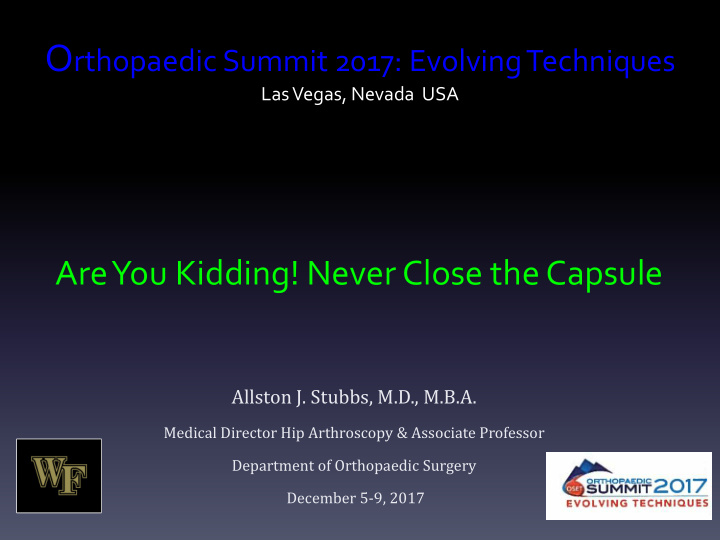



O rthopaedic Summit 2017: Evolving Techniques Las Vegas, Nevada USA Are You Kidding! Never Close the Capsule Allston J. Stubbs, M.D., M.B.A. Medical Director Hip Arthroscopy & Associate Professor Department of Orthopaedic Surgery December 5-9, 2017
Disclosure Consultant: Smith & Nephew • Stock: Johnson & Johnson • Research Support: Bauerfeind • Department-Division Support: Smith & Nephew, DePuy-Mitek, Arthex • Boards/Committees: AAOS, ABOS, AOSSM, ISHA, AANA, MASH, ISAKOS, Journal • of Hip Preservation Surgery
Aren’t we tired of this debate? • Didn’t exist until surgical techniques converted an arthroscopic procedure into an “open” one . . . • School of thought that opened the capsule had to return to the podium to remind (demand) one to close it • Let’s get back to doing arthroscopic surgery!
Risks with capsular sutures • Reaction to nonabsorbable suture SYNOVITIS • Over-tightening of joint STIFFNESS • Iatrogenic trauma to chondral surfaces OA • Heterotopic ossification of capsule HO • Increased case time FLUID EXTRAVASATION • Incarceration of anatomy (IP, rectus mm, glut mm) PAIN • Hemarthrosis/Effusion vessel tamponade AVN
Ask yourself 3 questions 1. What kind of surgeon are you? 2. What is hip instability? 3. What are you actually doing to the capsule? Do benefits outweigh risks?
First Question Are you an arthroscopic surgeon or are you an open surgeon? There is a difference!
Options for Scope “Access” • Capsulotomy: I, T, Inverted-T, H • Capsulectomy • Mini-Open Typical Goal: Replicate the open approach Is that wise?
T-Capsulotomy with Closure MRA PreScope MRA PostScope Iatrogenic Capsule Deficiency Despite Closure
MRI Arthrogram s/p capsulectomy BAD IDEA
What type of surgeon? Arthroscopic Open • Small holes • Large holes • Camera eye • Human eye • Micro instruments • Macro instruments • Deliver anatomy • Expose anatomy Orthopaedic principle: do not close puncture wounds
Primum Non Nocere Arthroscopy “Keyhole” joint preserving surgery Do you really want a hip endoscopy?!
Iatrogenic Capsular Compromise • Fluid Extravasation • Instrument Scissoring • Ligament Sectioning • Instability: Micro & Macro PAIN?
2017 Special Equipment • Portal placement guides • Flexible RF devices • Curved shavers/burs/guides • Dynamic tables • Percutaneous drill guides
Capsule Sparing Surgical Strategy • Portal dilation • Percutaneous instrument placement • Curved instrumentation • Smaller diameter instrumentation
Capsule Sparing Surgical Strategy • Synovial >> Capsular Sectioning • Pathology delivery • Avoid “fixed fulcrum” devices • Avoid “connecting the dots” and making “T” • Avoid capsulectomy
Capsulotomy Changes Fulcrum Skin Capsule PRE POST
Let’s Not Connect the Dots Skin Capsule Intraportal Capsulotomy Scissoring & Extravasation & Scarring
Second Question Do you believe that the native hip is inherently a stable joint or an unstable joint? There is a difference! arthrohealth.com.au
Let’s accept Hip Instability Exists • Rotational • Atraumatic vsTraumatic • Bone > Soft Tissue • Tx: PT Surgery
Can we learn from the shoulder? • Shoulder is less constrained joint than hip (ie, more prone to instability) • Shoulder arthroscopy is common • Routine portal closure in shoulder arthroscopy is uncommon • Capsulorrhaphy and Rotator interval closure in select shoulder patients
Hip Joint Restraints • Primary – Bony congruency – Ligaments • Secondary – Labrum – Ligamentum teres – Capsule and zona orbicularis – Muscle tendon units Intricate system that is only partially understood
Hip Instability Iatrogenic • Associated with compromise of normal dynamic and static stabilizers of the hip – Excessive acetabular resection (pseudoretroversion) – Capsulotomy/Capsulectomy – Ligamentum teres resection Zona orbicularis transection – • Postoperative trauma (early) Will capsular closure adequately address these Traumatic etiologies? • Associated with frank dislocation / subluxation Atraumatic • Association with labral tears, acetabular deficiency states, attritional FAI • Evidence of generalized ligamentous laxity Ehlers-Danlos syndrome – – Down syndrome – Idiopathic – DDH
Third Question Mmmm . . . Are you performing a capsular closure or are you performing a capsulorrhaphy ? There is a difference!
What’s the difference? Capsular closure Capsulorrhaphy • Anatomic side to side • Non-anatomic capsular approximation shift • May leave gaps • Pants-Over Vest concept • Tenuous around • Volume reducing anterosuperior region • Volume preserving
Classic “T” Closure Frank R et al. AJSM 2014
Capsulorrhaphy Domb et al Arthroscopy 2013
Pathologic Conditions • Bone defect/deficiency • Capsular laxity/deficiency • Ligament laxity/deficiency • Ligamentum teres deficiency
What to do . . . Leave alone Capsulorrhaphy • Portal based hip • Symptomatic collagen arthroscopy laxity • Arthritic changes • Acetabular dysplasia and soft tissue compromise • Adequate bony congruency • Chondrolabral preservation
Summary • Stay arthroscopic! – Strategic portal placement, dilation, minimal capsulotomy allow adequate access and treatment • Respect static & dynamic hip stabilizers – Know reportable complications of capsular compromise to avoid iatrogenic contributions • Strategic capsulorrhaphy – Recognize at risk instability patients
Cool Future Hip Meetings Cancun May 2019 www.isakos.org Melbourne October 2018 www.isha.net
Recommend
More recommend